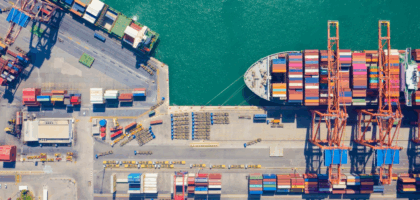In the extensive and complex world of logistics, proper documentation plays a pivotal role in ensuring smooth operations, timely deliveries, and compliance with global regulations. As the backbone of international trade, logistics documentation acts as the bridge that connects manufacturers, suppliers, vendors, distributors, and customers.
In this blog, we will explore the most common logistics documentation, shedding light on their importance, and how they contribute to the efficient movement of goods across borders.
Bill of Lading (BOL)
Often referred to as the “heart and soul” of international shipping, the Bill of Lading is a crucial document that serves as a contract between the carrier and the shipper. It also acts as a receipt for cargo and a document of title, allowing the holder to claim the goods upon arrival.
The BOL details the type and quantity of goods, the shipper, consignee, and carrier information, as well as the terms of transportation. A non-negotiable BOL must be signed by the parties listed, while a negotiable BOL can be transferred to a specified third party.
Why it’s important: A BOL is the most important shipping document in international shipping and must be included no matter the mode of transportation. It’s important to fully understand all the detailed information required to ensure your shipment is legally accepted. (Hint: That’s where your freight forwarder can help!)
Commercial Invoice
The commercial invoice is a vital document in global trade. It serves as a formal request for payment from the buyer to the seller and includes essential information, such as the description of goods, unit prices, total value, payment terms, and terms of delivery. Customs authorities use the commercial invoice to assess duties and taxes, making it essential for accurate valuation and classification of goods.
Why it’s important: The commercial invoice includes complete details of the transaction, which is required for customs clearance in freight shipping.
Packing List
A packing list is a detailed breakdown of the contents of each package within a shipment and helps validate the accuracy while also assisting customs officials during inspections. It includes information about item descriptions, quantities, weights, dimensions, as well as how the shipment has been packed and which marks and numbers are noted outside of the boxes.
Why it’s important: A packing list is used by freight forwarders in order for a shipment to clear U.S. customs for inspection, and often will be used in disputes between a shipper and carrier.
Certificate of Origin
The certificate of origin establishes the country where the goods were manufactured and is a critical document for customs clearance, as it determines eligibility for preferential trade agreements or tariffs. Different countries have specific requirements for certificate formatting and content, which is why this document is so important in remaining compliant.
Why is it important: This document helps to determine if goods are eligible for import and if they are subject to duties. It’s critical that shippers include this document to guarantee it meets all free trade agreements.
Proforma Invoice
A proforma invoice is a preliminary document sent by the seller to the buyer before the actual shipment and outlines the terms of the sale. This document facilitates smooth communication between parties and helps the buyer plan for the impending transaction. It can also exist in a transfer of ownership of goofs where no sale has occurred (such as gifts or COMAT). In this case, the proforma invoice reflects the value of the shipped merchandise rather than the sale value.
Why is it important: There are some countries’ customs authorizations that require the proforma invoice to compare with the actual commercial invoice to verify if the terms of trade match (like price and quantity).
Letter of Credit
A letter of credit is a primary means of payment in an international trade transaction and is irrevocable by default. It is issued by a creditworthy bank and guarantees payment on goods sold from a seller to a buyer. If the buyer cannot complete the payment, the bank pays the remaining amount to close the transaction.
Why is it important: International trade is complex due to varying rules and regulations by country, so this document with its monetary guarantee has become one of the safest forms of economic transaction.
Insurance Certificate
An insurance certificate provides evidence of insurance coverage for the shipment during transit. These certificates offer protection against potential risks, such as damage, theft, or loss, while the goods are in movement.
Why is it important: There is always a risk when shipping your goods, especially on an international scale. Having an insurance policy ensures that parties involved are financially protected in case an unforeseen event occurs.
International supply chains are complex and everchanging. By having the proper documentation, your shipments can continue to move seamlessly. Each piece of logistics documentation serves a specific purpose, collectively contributing to the efficient movement of goods across borders.
If you have any questions on international documentation, please reach out to your local ICAT office to learn more. Our subject matter experts are always willing to help navigate you through the process of moving your freight across the world.
Resources:
- Shipping Documents You Need When Transporting Your Cargo (Twill)
- 10 of the Most Common Shipping Documents (Easyship)
- Eight Essential Documents That Are Key to Shipping (More Than Shipping)



